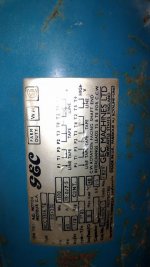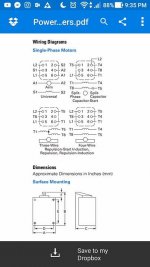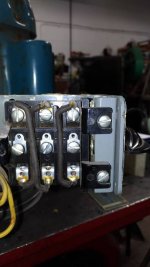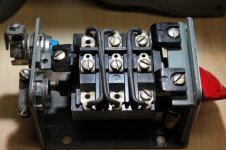PaulKrzysz
Plastic
- Joined
- Jun 29, 2015
Hello,
I'm swapping out the 1hp 600v motor that came with my Bridgeport for a 1.5hp 220v single phase motor. I will be reusing the original manual and reversing switch.
I'm not exactly sure how to hook up the motor to the drum switch correctly. I believe I found the manual for the original style of Cutler Hammer "O" drum switch, but I want to be sure as to which one is the correct diagram before I hook it up to any power.
My main concern is that the motor wiring diagrams wants P1 with L1, but under these diagrams there's no wire for P1, which is part of the thermal reset.
If anyone can point me in the right direction it would be greatly appreciated.
I'm swapping out the 1hp 600v motor that came with my Bridgeport for a 1.5hp 220v single phase motor. I will be reusing the original manual and reversing switch.
I'm not exactly sure how to hook up the motor to the drum switch correctly. I believe I found the manual for the original style of Cutler Hammer "O" drum switch, but I want to be sure as to which one is the correct diagram before I hook it up to any power.
My main concern is that the motor wiring diagrams wants P1 with L1, but under these diagrams there's no wire for P1, which is part of the thermal reset.
If anyone can point me in the right direction it would be greatly appreciated.
Attachments
-
 18051999_10212305215722986_1719210847_n.jpg58.9 KB · Views: 535
18051999_10212305215722986_1719210847_n.jpg58.9 KB · Views: 535 -
 18073156_10212305546131246_612110334_n.jpg30.3 KB · Views: 1,282
18073156_10212305546131246_612110334_n.jpg30.3 KB · Views: 1,282 -
 18073635_10212305553451429_535594050_n.jpg62.6 KB · Views: 1,004
18073635_10212305553451429_535594050_n.jpg62.6 KB · Views: 1,004 -
 18110414_10212305215802988_1866789353_n.jpg31.5 KB · Views: 1,328
18110414_10212305215802988_1866789353_n.jpg31.5 KB · Views: 1,328 -
 18110769_10212305215842989_121414897_n.jpg32.4 KB · Views: 511
18110769_10212305215842989_121414897_n.jpg32.4 KB · Views: 511









